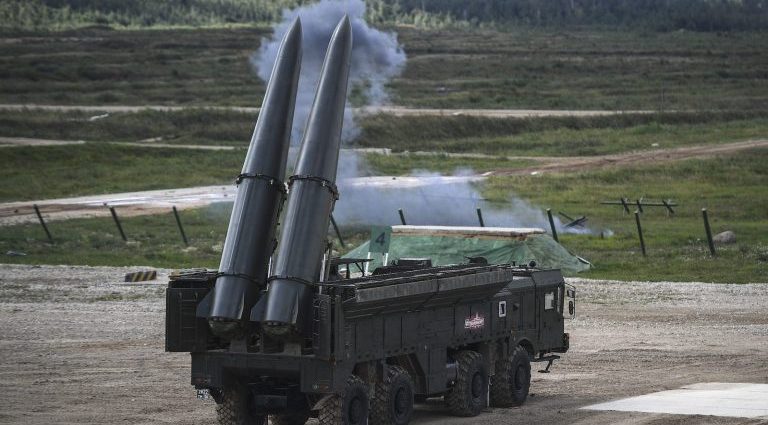Russia has used North Korean ballistic missiles against Ukraine while also seeking Iranian missiles, highlighting the deepening military cooperation among the sanctioned nations amid the ongoing Ukraine war.
This month, multiple media sources reported that Russia has used North Korean ballistic missiles to bombard Ukraine, aiming to degrade the latter’s critical infrastructure and morale amidst what appears to be an increasing stalemate on the battlefront.
Declassified US intelligence reports mention that Russia used North Korean short-range ballistic missiles (SRBM) on December 30 and January 2, and is planning to use those missiles in the coming weeks to hit Ukrainian targets as far as 885 kilometers away.
The North Korean missiles, most likely the KN-23 and KN-24 SRBMs, are analogous to the Russian Iskander-M and US MGM-140 Army Tactical Missile System (ATACMS). The KN-23 is estimated to carry a 500-kilogram warhead 450 kilometers or 690 kilometers with a reduced payload and can perform evasive maneuvers to avoid interception.
Its similarity to Iskander-M has led to speculation that it was designed with foreign assistance. The KN-24 is believed to carry a 400 to 500-kilogram warhead up to 410 kilometers and, as with the KN-23, maneuver in flight to defeat missile defenses.

Russia is also reportedly seeking to source SRBMs from Iran, which has previously supplied Russia with Shahed loitering munitions and ammunition for its war on Ukraine. However, it is unclear if Iran has delivered the weapons.
Iran could potentially supply Ababil and Fateh SRBMs. The Ababil is a close-range ballistic missile (CRBM) with an 86-kilometer range, a 45-kilogram warhead and an optical seeker guidance system. The larger Fateh is an SRBM with a 200 to 300-kilometer range, a 450 to 600-kilogram warhead, and a GPS or INS guidance system.
Autocratic Russia, Iran and North Korea have common cause in their disdain for the Western-dominated international order and as heavily sanctioned economies.
While Russia has burned through its prewar missile stockpiles, it has ramped up production to sustain its aerial bombardment campaign against Ukraine. At the same time, the US and its allies have sought to hobble Russia’s missile production through severe sanctions, which appear to have only partially hit their prohibitive mark.
In September 2023, The New York Times reported that Russia has overcome Western sanctions and export controls to expand its missile production above prewar levels. The New York Times mentions that while Western sanctions forced Russia to dramatically slow missile production for six months from February 2022, the time of the initial invasion, Russia’s defense industry began to regain speed by that year’s end.
Russia’s arms producers are surprisingly dependent on Western-made components, An August 2022 study by the Royal United Services Institute (RUSI) said that 450 foreign-made components were found in 27 of Russia’s most modern military equipment and weapons including cruise missiles, electronic warfare complexes and communications gear.
The majority of the parts were manufactured by US companies involved in supplying sophisticated electronics for the US military. The report said 80 different components that ended up in Russia were subject to US export controls.
The same New York Times report said that while Russia has used its intelligence services to run covert networks to smuggle processors and circuit boards for missiles, it still faces a shortage of explosives and propellants.
While those electronics can easily be hidden in backpacks, energetics are much harder to smuggle over borders. As such, Russia has reached to North Korea and Iran to fill its missile energetics production gap.
The Ukraine war has brought North Korea and Russia together in a quid pro quo partnership, with Pyongyang providing weapons and Moscow much-needed economic relief and missile technology.
North Korea’s military is equipped with Soviet or Russian-standard weaponry. Despite international isolation and the impact of severe sanctions, Pyongyang still maintains a robust arms industry and missile program.
Both sides in the Ukraine war are suffering from severe artillery shell shortages, with Ukraine’s Western allies struggling to scale up production of 155-millimeter artillery rounds.
In November 2023, the Associated Press reported that North Korea is believed to have sent one million artillery rounds to Russia, with Pyongyang running its factories at full production and sending instructors to Russia to teach Moscow’s military personnel how to use the weapons.

North Korea’s support for Russia’s war effort may stem from a belief that a Russian victory would lead to the repeal of US sanctions on its impoverished economy and thus reduce its current overreliance on China as its main economic and political lifeline.
The Ukraine war has also brought Russia and Iran in closer alignment, with Moscow seeking Tehran’s political and military support to sustain its war effort and Iran viewing the conflict as an opportunity to win military, economic and political support from a nuclear technology leader and energy superpower.
Russia initially supported Western sanctions on Iran’s nuclear program with the view that having yet another nuclear-armed state in Asia would unfavorably impact the regional balance of power.
However, Iran may have found an opportunity in the Ukraine war to make itself indispensable to Russia’s war effort, increasing its bargaining power over the latter to assist in its nuclear program, modernize its obsolete conventional military and secure Russian commitment to the International North-South Transport Corridor (INSTC), seen by some as a sanctions evasion route for Iran and now also Russia.

